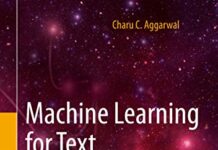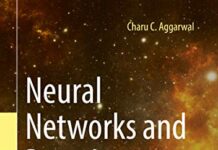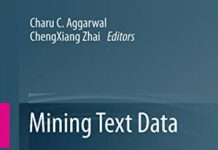
Ebook Info
- Published: 2015
- Number of pages: 764 pages
- Format: PDF
- File Size: 8.89 MB
- Authors: Charu C. Aggarwal
Description
This textbook explores the different aspects of data mining from the fundamentals to the complex data types and their applications, capturing the wide diversity of problem domains for data mining issues. It goes beyond the traditional focus on data mining problems to introduce advanced data types such as text, time series, discrete sequences, spatial data, graph data, and social networks. Until now, no single book has addressed all these topics in a comprehensive and integrated way. The chapters of this book fall into one of three categories: Fundamental chapters: Data mining has four main problems, which correspond to clustering, classification, association pattern mining, and outlier analysis. These chapters comprehensively discuss a wide variety of methods for these problems. Domain chapters: These chapters discuss the specific methods used for different domains of data such as text data, time-series data, sequence data, graph data, and spatial data. Application chapters: These chapters study important applications such as stream mining, Web mining, ranking, recommendations, social networks, and privacy preservation. The domain chapters also have an applied flavor. Appropriate for both introductory and advanced data mining courses, Data Mining: The Textbook balances mathematical details and intuition. It contains the necessary mathematical details for professors and researchers, but it is presented in a simple and intuitive style to improve accessibility for students and industrial practitioners (including those with a limited mathematical background). Numerous illustrations, examples, and exercises are included, with an emphasis on semantically interpretable examples.Praise for Data Mining: The Textbook – “As I read through this book, I have already decided to use it in my classes. This is a book written by an outstanding researcher who has made fundamental contributions to data mining, in a way that is both accessible and up to date. The book is complete with theory and practical use cases. It’s a must-have for students and professors alike!” — Qiang Yang, Chair of Computer Science and Engineering at Hong Kong University of Science and Technology”This is the most amazing and comprehensive text book on data mining. It covers not only the fundamental problems, such as clustering, classification, outliers and frequent patterns, and different data types, including text, time series, sequences, spatial data and graphs, but also various applications, such as recommenders, Web, social network and privacy. It is a great book for graduate students and researchers as well as practitioners.” — Philip S. Yu, UIC Distinguished Professor and Wexler Chair in Information Technology at University of Illinois at Chicago
User’s Reviews
Reviews from Amazon users which were colected at the time this book was published on the website:
⭐This is an excellent book both in depth and breadth ofthe topics covered. It gives descriptions, analyses, and insightsabout the most popular algorithms on various topics, and it coversmany more areas than most books. The book is well integrated acrossthe broad diversity of topics that are covered, and connections betweenmethods and topics are pointed out throughout the book. I wouldn’tagree with an earlier review that the descriptions are short orintroductory. For most of the important topics, a lot of detail isprovided in terms of algorithm description and pseudo-code.In some cases, interesting analyses are also provided. For instance,in the case of frequent pattern mining algorithms,not only are more algorithms discussedthan most of the other books, but a discussion of multiple choicesof data structures for the same algorithm is provided,along with their relative trade-offs. The relationships among various algorithms are also discussed. I have seen quite afew textbooks on data mining, and I have not seen anything close to thislevel of detail in any of the other books. Overall, my impression isthat the author has done an excellent job of calibrating detail levelto topic importance. Therefore, it can serve both as a textbook andas a reference book. On the other hand, this is certainlynot an implementation or programming-centric book. The book is good atteaching principles and concepts.
⭐This is an excellent survey of analytics and data mining models; it’s unsuitable as a first book on the topic, but would be excellent as a 3rd or 4th. The great strength is the organized taxonomy in which techniques and subcomponents of techniques are presented. This also leads to some idiosyncracies, such as calling linear regression an advanced special case of classification, which is not a mainstream view.The strongest parts of the book are his descriptions of common components, such as distance functions, or meta algorithms; knowing about these concepts is often enough to implement them. The weakest parts are the description of individual algorithms, which are often too terse to follow unless you already understand what the algorithm or a related one does.The best way to use this book is to first read one of the classics (e.g. Hastie and Tibshirani), and then read this book to fill in more options for how to alter and combine techniques. This book also has significant coverage on association mining (i.e. recommender systems) which tend not to be treated elsewhere.Aggarwal deserves to be better known; I’ve read 3 of his books and so far all of them have been excellent.
⭐As far as I know, this is the first book to try to systematize data mining into a science. Dr. Aggarwal does a good job of relating the different parts of data mining to one another so that one can see data mining as a discipline and not simply various techniques. One caveat, as somebody who makes a living by data mining, I can say that this text is more appropriate for academia than real analytic work. Practitioners with experience in data mining can understand the theoretical parts of data analysis better and undergraduate and graduate students can benefit from this theoretical perspective, but readers looking for an introduction to data mining in a real world setting should choose a different text.
⭐This book is a great resource on data mining. In the past, I found that these types of books are written either from a “data mining” perspective, or from a “machine learning” perspective. Data mining books frequently omit many basic machine learning methods such as linear, kernel, or logistic regression. However, machine learning books do not address basic data mining methods like association rules or outlier detection. This book finally provides about as complete coverage as one can hope to get from a single book. Two chapters are devoted to outlier detection. A remarkable and unusual feature is that methods for specific data types are covered in individually dedicated chapters. Even topic models are discussed, which are absent from information retrieval books.
⭐Fantastic book to read and very informative . One of the best books i ever bought. read it from start to finish . if you want to learn or understand what data Mining is all about . This is it
⭐Charu has again proved his expertise in the field. Book is great in breadth and depth.
⭐Nice reference, but it’s not a textbook. This is a huge compendium of short snippet-like introductions to various techniques in data mining. I can’t imagine this being used as a textbook, though, and no, simply including exercises at the end of each chapter does not qualify.
⭐This book is comprehensive and awesome, worth it!
⭐The pages started falling out as soon as I opened it. Disgraceful, considering the price I paid.
⭐An excellent book with extensive and exhaustive topics covered.My purpose of study was not academic, but practical, and the books serves as an excellent guide. The equations are followed by intuitions and explanations, which are thorough and step by step, but not rudimentary. You might still need basics of algebra and probability up in your artillery.The book comes in hardcover with excellent binding with thick papers which brings value to the price worth 5400+.Recommend!
⭐Do not buy the Kindle edition of this book! On my kindle HDX, the formulas are very small and it is impossible to read them without a magnifying glass. If the text size is increased, the formulas still stay small. I really regret that I have bought this book in the kindle edition. The sad thing is that springer offers this book in pdf format and in that format the formulas are nicely set. Unfortunately I discovered this only when it was too late and I had already bought the kindle edition. It is really a shame that amazon has done such a poor job to this book.
⭐Average product
⭐Attenzione a prendere la versione con la copertina flessibile, il tempo di una prima sfogliata e già 3 pagine sono volate via. Spero che con il tempo non si dimezzi il numero delle pagine.
⭐
Keywords
Free Download Data Mining: The Textbook 2015th Edition in PDF format
Data Mining: The Textbook 2015th Edition PDF Free Download
Download Data Mining: The Textbook 2015th Edition 2015 PDF Free
Data Mining: The Textbook 2015th Edition 2015 PDF Free Download
Download Data Mining: The Textbook 2015th Edition PDF
Free Download Ebook Data Mining: The Textbook 2015th Edition





